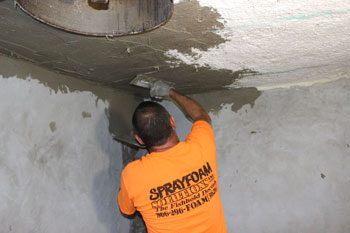Technology Brings Fish Hold Into
21st Century

Applying a coat of structural cement over 6 inch thick layer of closed cell foam in a fish hold at the New Bedford waterfront. This step will be followed by a layer of white antimicrobial polyurea. The result is a colder cleaner fish hold. Fishermen’s Voice photo
America’s largest by landings value fishing port is looking at maximizing the return on fishing trips. Some New Bedford vessel owners are upgrading their vessels’ fish hold insulation, effectively converting the fish hold into a refrigerator. Ice can determine the length of a fishing trip and the quality of product when landed.
Conditions, including water temperature, can produce unpredictable lifespans for a load of ice in fish holds with typical insulation. In addition, new Food and Drug Administration (FDA) regulations require insulation materials and methods that reduce bacterial problems in fish holds.
Chad Maguire is a partner in five New Bedford fishing boats. Two of them recently had the fish holds upgraded with a Sprayfoam insulation system. Maguire, said of the new insulation system in his boat, “Ice is no longer a determinant in the length of a fishing trip.” The technique was developed by insulation contractor Richard Mauzorelle of Sprayfoam, Inc. After the old open cell insulation foam is removed from the hold, the new system is installed. The Sprayfoam system incorporates a 6-inch thick layer of 3-lb. closed cell foam over floor of the fish hold. All walls and overhead are covered with 2-lb. closed cell foam. After the foam is planed smooth, it is covered with a structural coat of cement, then primed with a bonding primer. It is then coated with a finish layer of bright white polyurea, a zero microbial, food safe and FDA approved product. The polyurea also remains flexible in changing humidity and temperature. The floor, depending on the boat, gets four to six inches of 3000 psi fibered cement.

One of the finished pens in a fish hold before aluminum pen boards are installed. Trough at bottom of white pen releases water from any melted ice.
The new fish hold looks and feels like a low temperature walk-in refrigerator.
Mauzorelle said he developed the rebuilding technique for fish holds over the last 15 years by constantly upgrading the method. The Sprayfoam retains the ice longer with a number of benefits beyond the cost of ice. Fishermen report bring back most of the ice they left port with two weeks earlier. Because the ice does not melt as fast, scallops are not sitting in and taking up water. The result is they bring top dollar when landed.
Scallop trips can last 4 days to a week or 10 days to 2 weeks. Travel time can be 24 to 30 hours to the fishing grounds. Unpredictable ice loss on a trip, which can be half the ice lost while steaming from New Bedford to New Jersey to fish, can mean having to cut a trip short or risk landing scallops that have gone bad in a hold without ice. Trips have been called off, said Mauzorelle, when the vessel runs into warm water eddies that melt the ice in the hold faster.
Mauzorelle expects the FDA will be inspecting fish holds in the near future. In addition to the zero microbial polyurea, the pen boards, which hold the ice and product in the hold’s pens, are now aluminum. Stainless steel buckets are replacing the plastic buckets used to handle product and ice.
